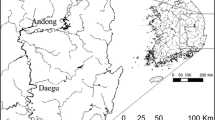Abstract
This study documents the increased distribution of mangrove communities into the oligohaline regions of the Mánamo river as a consequence of a dam constructed in 1965. The dam caused a major change in the discharge regime of the water, stopping the annual floodings and allowing an extensive upriver intrusion of saline waters. Penetration of salt water from the sea due to the daily tides, that would be observed only during the dry season, occurs now throughout the year.
Three sites were chosen along the upper, middle and lower river course. The evolution of site geomorphology and vegetation was evaluated over 3 periods, from 1932 to 1996, using aerial photographs and recent field surveys. Soil and plant samples were taken in the mangrove communities of two sites nearer to the river mouth along 100 m transects inland from the river fringe. The influence of sea water in soils was measured by the concentration of Na, Mg, Cl and SO4 in the interstitial soil water. In plants, the impact of soil salinity was determined by the concentration of Na, K, and Mg in mature leaves.
The geomorphological processes created new habitats (sand bars) for aquatic and terrestrial vegetation. In the middle and lower river course tidal penetration of sea water due to lower river discharge salinized the soil, allowing mangrove establishment. This occurred mainly in the open sand bars or in areas with sparse herbaceous vegetation. The ion content was higher in the down river site and also higher in the subsoils compared with the topsoils. The apparent expansion rate of a plant community dominated by a mangrove species (Rhizophora mangle) increased from 1 ha yr−1 prior to the regulation of water flow, to 6–7 ha yr−1 after the river closure. The dam influences the entire Mánamo river basin, affecting the distribution of halophytic species along the river fringes.
Similar content being viewed by others
References
Abacus Concepts, StatView. 1992. Abacus Concepts, Inc. Berkeley California.
Botero, L. 1990. Massive mangrove mortality on the Caribbean coast of Colombia. Vida Silvestre Neotropical 2 (2): 77–78.
Botero, L. & Mancera-Pineda, J. E. 1996. Síntesis de los cambios de origen antrópico ocurridos en los Últimos 40 años en la Ciénaga de Santa Marta (Colombia). Rev. Acad. Colomb. Cienc. 20 (78): 465–474.
Canales, H. 1985. Determinación del potencial forestal del Territorio Federal Delta Amacuro. Ministerio del Ambiente (MARNR) Caracas.
Colonnello, G. 1996. Aquatic vegetation of the Orinoco River Delta (Venezuela). An Overview. Hydrobiologia 340: 109–113.
Escalante, B. 1993. La intervención del Caño Mánamo en el Delta del Orinoco y su repercusión en el medio ambiente vista por los deltanos. Pp. 201–253. In: Monente, J. A. & Vásquez, E. (eds), Estudio limnológico y aportes a la etnología del Delta del Río Orinoco. Fundación La Salle de Ciencias Naturales, Caracas.
Herrera, L. E., Febres, A. G. & Avila R. G. 1981. Las mareas en aguas venezolanas y su amplificación en la región del Delta del Orinoco. Acta Científica Venezolana 32: 299–306.
Huber, O. and Alarcón, C. 1988. Mapa de la vegetación de Venezuela. 1:2 000 000. Caracas: MARNR, The Nature Conservancy.
Hueck, K. 1960. Mapa de Vegetación de la RepÚblica de Venezuela. Escala 1:2 000 000 Instituto Forestal Latinoamericano de Investigación y Capacitación. Mérida, Venezuela.
MARNR (Ministerio del Ambiente y de los Recursos Naturales Renovables). 1982. Mapa de la vegetación actual de Venezuela. Dirección General Sectorial de Información e Investigación del Ambiente. Proyecto VEN 79/001/B. Sistemas Ambientales Venezolanos.
Medina, E. & Francisco, M. 1997. Osmolality and δ13C of leaf tissues of mangrove species from environments of contrasting rainfall and salinity. Estuarine, Coastal Shelf Sci. 45: 337–344.
Pannier, F. 1976. Mangroves impacted by human-induced disturbances: A case study of the Orinoco Delta Mangrove Ecosystem. Env. Manag. 3: 205–216.
Rodríguez, G. 1987. Structure and production in Neotropical mangroves. TREE 9: 264–267.
Trask, P. D. 1955. Recent marine sediments: A Symposium. The American Association of Petroleum Geologists. Dover Publications, Tulsa, Oklahoma.
Twilley R. R., Snedaker S. C., Arancibia and Medina, E. 1995. Mangrove systems. Pp. 387–393. In: Heywood V. H. (executive editor). Global Biodiversity Assessment. Biodiversity and Ecosystems Functions: Ecosystems Analyses. United Nations Environment Programme. Cambridge University Press, Cambridge.
Sifontes, E. 1951. El Orinoco, su navegación entre Ciudad Bolívar y Pedernales. Notas hidrometereológicas. Hidrología Venezolana. Imprenta Nacional, Caracas 201.
Van Andel, T. H. 1967. The Orinoco Delta. J. Sedimentary Petrol. 37: 297–310.
Author information
Authors and Affiliations
Rights and permissions
About this article
Cite this article
Colonnello, G., Medina, E. Vegetation changes induced by dam construction in a tropical estuary: the case of the Mánamo river, Orinoco Delta (Venezuela). Plant Ecology 139, 145–154 (1998). https://doi.org/10.1023/A:1009785118019
Issue Date:
DOI: https://doi.org/10.1023/A:1009785118019




